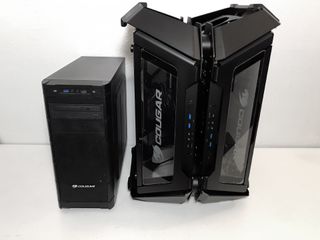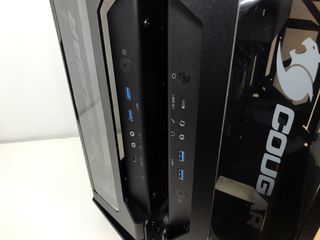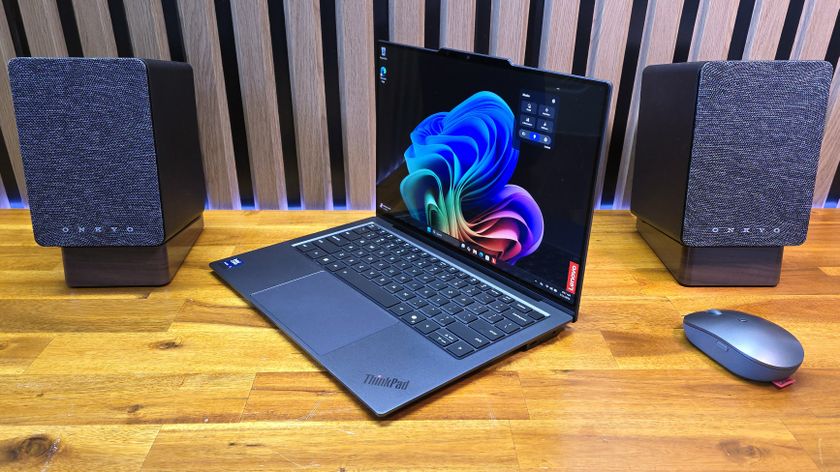Tom's Hardware Verdict
There are too many things wrong with the design of this case, especially given the high price, for us to recommend it to anyone. Even if you put aside the laundry list of issues, the Gemini X takes up more space than two full-sized ATX cases standing side by side, and delivers sub-par thermal performance, thanks to its lack of any included fans.
Pros
- +
High quality materials
- +
Extremely cool looking
- +
Unique concept
Cons
- -
Huge and heavy
- -
No fans or fan hub included
- -
Must remove motherboard to replace heatsink
- -
Must remove fans to service or replace filters
- -
Must remove PSU to replace or add SSDs
- -
Water cooler fitment issues on Mini-ITX side
- -
No hard drive caddies or vibration dampers
- -
Fan holes are left open without fans
- -
Extremely tight hard drive fit
- -
Thicker dual slot GPUs are blocked by PSU on Mini-ITX side
- -
Serious cable routing issues
Why you can trust Tom's Hardware
Features and Specifications
It's probably fair to say that a $700 (£ 534.52)-MSRP dual-chambered case with room for two complete system builds (one ATX, one Mini-ITX) occupies a fairly small niche in the PC builder space. But with the seemingly ever-increasing number of gamer streaming their exploits for fun and profit, a premium dual-system chassis is probably a bigger niche than you might think. Cougar's Gemini X is huge, with an equally grandiose price ($561 on Amazon when we wrote this and $620 on Newegg), that targets a specific group of gamers who want a high-end gaming system and a Mini-ITX streaming build all in the same case. But a host of issues, plus the high price and missing basic features (like fans) make it tough to recommend to anyone.
Specifications
| Type | Dual Compartment Chassis |
| Motherboard Support | Mini-ITX, Micro-ATX, ATX |
| Dimensions (HxWxD) | 20.67" x 10.04" x 24.02 inches (426 x 635 x 525mm) |
| Space Above Motherboard | 3 inches (76.2mm) |
| Card Length | Primary: 13.77 inches (350mm) Secondary: 12.99 inches (330mm) |
| CPU Cooler Height | Both sides 5.51 inches (140mm) |
| Power Supply Format | ATX and SFX |
| Weight | 39lbs (17.7kg) |
| External Bays | ✗ |
| Internal Bays | 3x 3.5" / 3x 2.5” |
| Card Slots | 7 |
| Ports/Jacks | 2x USB 3.0, audio/mic jacks |
| Front Fans | ✗ |
| Rear Fans | ✗ (Up to 2x 120mm / one per side) |
| Top Fans | ✗ (Up to 2x 120mm / one per side) |
| Bottom Fans | ✗ (Up to 2x 120mm / one per side) |
| Side Fans | ✗ |
| Damping | ✗ |
| Warranty | One year |
Exterior
Once you get it out of the box, the first thing you notice about the Gemini X is its size. In the image below, you can see just how large this case is compared to a standard ATX mid-tower chassis. In fact, this case is almost the same size as two full-tower cases standing side by side. It would be understandable if the Gemini X could house two full-sized systems, but the fact that one side is dedicated to a mini-ITX build makes its size somewhat ridiculous.

Constructed of black anodized aluminum and tempered-glass, the Cougar Gemini X can be orientated either horizontally and vertically. Measuring a massive 20.7 x 10 x 24inches (426 x 635 x 525mm), it also tips the scales at just under 39lbs (17.7 kg) when empty. In the vertical position, the four top and bottom panels are bare with the exception of two 120mm fan holes per panel, for a total of eight open fan holes. There are no fan grills included with this chassis and, in order to use the included fan filters, two 120mm fans must be installed per mounting location.




The front of the chassis is fitted with tempered glass panels emblazoned with the Cougar logo. The leading edge between both halves of the chassis is home to USB 3.1 Type-C, two USB 3.0 ports, headphone and microphone jacks, a hard drive activity LED, and a reset and power button for each side of the case.

The side panels are made of 5mm-thick darkly tinted tempered glass, which is bonded to 4mm-thick metal frames and held in place by rubber-coated locating pins and large thumbscrews.




Metal mesh inserts in the rear of the chassis are held in place by thumb screws on each end. The panels cover openings for both power supplies and a total of ten expansion-card slots, eight in the primary compartment and two in the secondary.

Four aluminum bars with large rubber feet keep the chassis elevated a half inch when positioned horizontally or two inches off the ground when in the horizontal position.

The fan filtration system is a mixed bag at best. By design, the only way to use the included fan filters is to populate the fan holes with two 120mm fans per panel (not included). These filters are sandwiched between the fans and the frame of the chassis. End users could opt to install intake fans on one end of the system with a filter in place and leave the mounting locations on the opposite end of the chassis open without filters, but that would be less than optimal for preventing dirt and dust particles from entering your system. Ideally, allfan mounting locations should be populated with filters between the 120mm fans and the frame. This design also makes it a hassle to remove filters for cleaning.
MORE: Best Cases
MORE: All Case Content
Current page: Features and Specifications
Next Page Hardware Installation and Test Configuration











